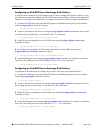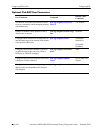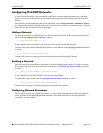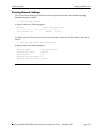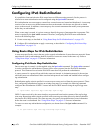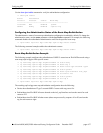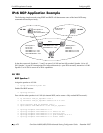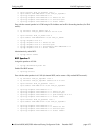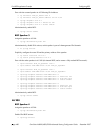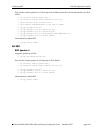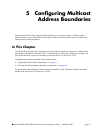
Configuring IPv6 Redistribution Configuring BGP
page 4-76 OmniSwitch 6800/6850/9000 Advanced Routing Configuration Guide December 2007
Configuring IPv6 Redistribution
It is possible to learn and advertise IPv6 routes between different routing protocols. Such a process is
referred to as route redistribution and is configured using the ipv6 redist command.
IPv6 redistribution uses route maps to control how external routes are learned and distributed. A route map
consists of one or more user-defined statements that can determine which routes are allowed or denied
access to the network. In addition, a route map may also contain statements that modify route parameters
before they are redistributed.
When a route map is created, it is given a name to identify the group of statements that it represents. This
name is required by the ipv6 redist command. Therefore, configuring IPv6 BGP route redistribution
involves the following steps:
1 Create a route map, as described in “Using Route Maps for IPv6 Redistribution” on page 4-76.
2 Configure IPv6 redistribution to apply a route map, as described in “Configuring IPv6 Route Map
Redistribution” on page 4-76.
Using Route Maps for IPv6 Redistribution
A route map specifies the criteria that are used to control redistribution of routes between protocols. Route
maps that are used for redistributing both IPv4 and IPv6 routes are created in the same way. Refer to
“Using Route Maps” on page 4-53 for more information.
Configuring IPv6 Route Map Redistribution
Once a route map is created, it is then applied using the ipv6 redist command. The ipv6 redist command
is used to configure the redistribution of routes from a source protocol into the IPv6 BGP destination
protocol. This command is used on the IPv6 BGP router that will perform the redistribution.
A source protocol is a protocol from which the routes are learned. A destination protocol is the one into
which the routes are redistributed. Make sure that both protocols are loaded and enabled before configur-
ing redistribution.
Redistribution applies criteria specified in a route map to routes received from the source protocol. There-
fore, configuring redistribution requires an existing route map. For example, the following command
configures the redistribution of OSPFv3 routes into the IPv6 BGP network using the ospf-to-bgp route
map:
-> ipv6 redist ospf into bgp route-map ospf-to-bgp
OSPFv3 routes received by the router interface are processed based on the contents of the ospf-to-bgp
route map. Routes that match criteria specified in this route map are either allowed or denied redistribu-
tion into the IPv6 BGP network. The route map may also specify the modification of route information
before the route is redistributed. See “Using Route Maps” on page 4-53 for more information.
To remove a route map redistribution configuration, use the no form of the ipv6 redist command. For
example:
-> no ipv6 redist ospf into bgp route-map ospf-to-bgp




